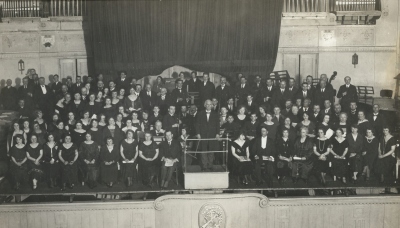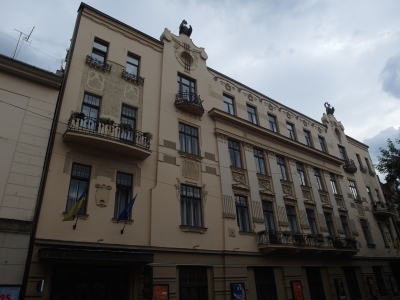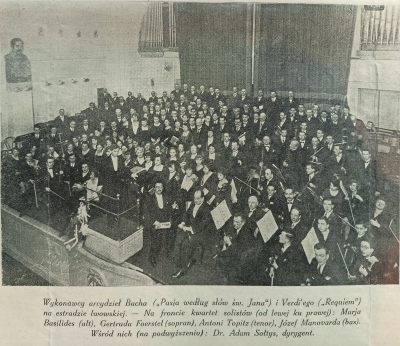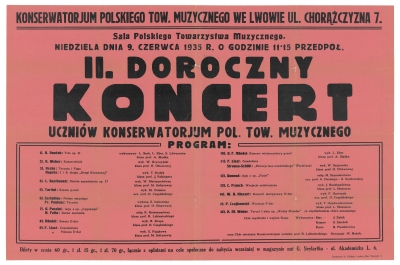The institution was founded in 1838, operating initially as the Galician Music Society (GMS) and from 1919 to 1939 as the Polish Music Society (PTM).
(it formally received conservatoire status in 1880). For many years, the GTM/PTM and its Conservatoire were headed by Mieczysław Sołtys (1863–1929) and his son Adam Sołtys (1890–1968). The GTM/PTM President (and curator of the National Ossoliński Institute) was Prince Andrzej Lubomirski (1862–1953). In 1906 the GTM and its Conservatoire moved to its newly erected seat at 7 Chorążczyzny Street, designed by well-known Polish Art Nouveau architect Władysław Sadłowski. 1910 saw the inauguration in that building, with a concert hall seating seven hundreds, which was one of the city’s three main music venues (apart from the Municipal Theatre and Lwów Philharmonic). The Conservatoire also had a 150-seat chamber music hall.
It was in the PTM great concert hall that the world premiere of (the full orchestral version of) Karol Szymanowski’s Symphony No. 3 ‘Song of the Night’, Op. 27 took place in 1928 under the baton of Adam Sołtys. Other major events held there were Prof. Kazimierz Twardowski’s university lectures, Tadeusz Boy Żeleński’s popular presentations, and Hanka Ordonówna’s recitals.
including the world premieres of Sielanka (Idyll) Op. 4 (1928) and Sonatina Op. 12 (1930, at the evening organized by Maksymilian Tuerk's Concert Bureau), performances of the orchestral 15 Variations Op. 9a (1932), Musique. Quasi una Sonata Op. 8 for piano, and again the Sonatina (1934), as well as the world premiere of Symphony No. 1, Op. 11 (1936, a concert organized by the Lwów Philharmonic, broadcast live on the radio). In January 1939, Koffler's Variations on a Theme by Johann Strauss Op. 23 was performed at the Polish Music Society hall.





In 1926, it employed 46 faculty members and enrolled 926 students of both genders. Koffler was on the faculty of the PTM Conservatoire for fifteen years (1924–1939) as a teacher of theoretical subjects, including harmony. In 1928 he took up the post of atonal harmony and composition, which was the only such a specialised class of composition in Poland. Among Koffler's students were Ryszard Apte (died c. 1942), Czesław Halski (active in London from 1944), Roman Haubenstock-Ramati (active in Kraków, Tel Aviv, Paris, and Vienna after 1945), Jakub Mund (died c. 1942), and Zbigniew Szymonowicz (active in Łódź after 1945).
The PTM was wound down at the start of the Soviet occupation (1939–1941) and Lviv State Conservatoire (LGK) (operating from January 1940 till June 1941) was launched in the former PTM building. Koffler was responsible for the Chair of Composition and was a deputy dean at the LGK. When the German occupying forces took over Lwów (Lviv), the Conservatoire was closed down in the summer of 1941.









